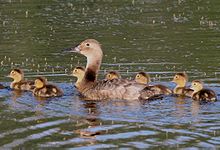Canvasback duck
| Canvasback | |
|---|---|
 |
|
| Male | |
 |
|
| Female with ducklings | |
| Scientific classification | |
| Kingdom: | Animalia |
| Phylum: | Chordata |
| Class: | Aves |
| Order: | Anseriformes |
| Family: | Anatidae |
| Genus: | Aythya |
| Species: | A. valisineria |
| Binomial name | |
|
Aythya valisineria (Wilson, 1814) |
|
| Synonyms | |
|
Aythya vallisneria (lapsus) |
|
Aythya vallisneria (lapsus)
The canvasback (Aythya valisineria) is a species of diving duck, the largest found in North America.
It ranges from 48–56 cm (19–22 in) in length and weighs 862–1,600 g (1.900–3.527 lb), with a wingspan of 79–89 cm (31–35 in). It is the largest species in the Aythya genus, being similar in size to a mallard but with a heavier and more compact build than it. 191 males wintering in western New York averaged 1,252 g (2.760 lb) and 54 females there averaged 1,154 g (2.544 lb). The canvasback has a distinctive wedge-shaped head and long graceful neck. The adult male (drake) has a black bill, a chestnut red head and neck, a black breast, a grayish back, black rump, and a blackish brown tail. The drake's sides, back, and belly are white with fine vermiculation resembling the weave of a canvas, which gave rise to the bird's common name. The bill is blackish and the legs and feet are bluish-gray. The iris is bright red in the spring, but duller in the winter. The adult female (hen) also has a black bill, a light brown head and neck, grading into a darker brown chest and foreback. The sides, flanks, and back are grayish brown. The bill is blackish and the legs and feet are bluish-gray. Its sloping profile distinguishes it from other ducks.
The genus name is derived from Greek aithuia, an unidentified seabird mentioned by authors, including Hesychius and Aristotle. The species name valisineria comes from the wild celery Vallisneria americana, whose winter buds and rhizomes are the canvasback's preferred food during the nonbreeding period. The celery genus is itself named for seventeenth century Italian botanist Antonio Vallisneri.
The duck's common name is based on early European inhabitants of North America's assertion that its back was a canvas-like color. In other languages it is just a white-backed duck; for example in French, morillon à dos blanc, or Spanish, pato lomo blanco. In Mexico it is called pato coacoxtle.
...
Wikipedia

